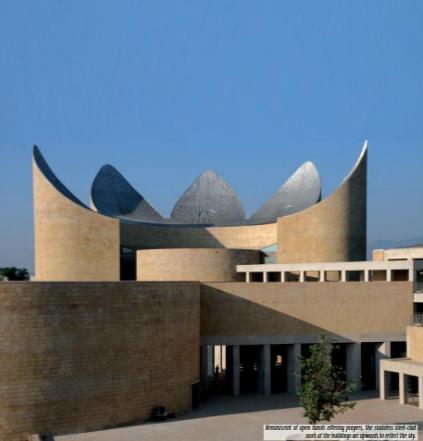AN AMOUR AND MORE
NASA: JRNM: 021
Oblivion
Virasat-e-Khalsa, the building that speaks for the community of the Sikhs, the Khalsa's.


An ancestral belief cast in sandstone, Virasat-e-Khalsa stands at a contrast from the prominent white surroundings in Anandpur Sahib. The holy city has a multitude of gurudwaras which flaunt their white coloured facades; amongst all this whitely heaven lies and emit an aura of peace and serenity, the sandstone cladded gate whispers that it is not going to be just any other building, but a gateway into the history to the city. It is juxtaposing how the most recent building in the vicinity will take us back into the history and hold witness to the ‘virasat’ of the Khalsas.
The transition of feelings on approaching a 123-meter-high structure from a mere 7-meter gate is drastic. Even at the purlieus of the Virasat -e-Khalsa the building does not give away its vital view, just yet. Waiting in the line by the ticket counter heightens the curiosity of the visitor.
The first glance
Standing in front of the museum, the huge structure overpowers you, forces you to lift your head in admiration. The great altar in orange resemble the mighty canyon, with a huge artificial lake at its foot escorted by a river of visitors gushing away eagerly. The humongous artificial lake not only brings a sense of cool to the area but amplifies the height of the building two folds through the reflection in the water. One can stand there and stare at the structure all day long; and hence the park placed right in front for the romantic in us to stare and maybe fall in love with the structure.
On a deeper and careful look one can hear the poem the building is singing. The petal liked structures on the top give a sense of fragility to the building and make the museum seem like it is a flower which has risen from the holy earth of Anandpur Sahib to sing the melodies of the Khalsa inheritance. Each steel cladded petal facing the bright sun outshines the monotonous and dull sandstone façade of the building; each one ready to tell a different anecdote of the ancestors. These curved petals with their fragile curves resemble delicately folded hands facing towards the Gurudwara. On another note, one could also say that the petals when looked from a certain angle somewhat resemble turbans hence, you’ll see proud Sikhs in turbans head held high.
The approach
By now you’ll think that you might just be infatuated to the building and hence after taking one last long gaze at the structure you walk forward, wishing to get closer and to explore the building in and out and leave no corner untouched.
The two wings of the museum are connected by a 165-meter bridge. The significance of this bridge is symbolic. The walk on the bridge towards the gallery of exhibitions gives you a whole new experience; from this elevation not only does the surrounding look more perceivable but the building seems more “approachable” as well. And hence, the walk towards the museum is that of anticipation and curiosity




On nearing the museum one feels some abstract tingling sensation on their toes as they saunter towards the awaiting exhibition galleries; the stretch simulates the approaching visitor with each foot on.
The Climax
The wait is over and you’re right in front of the entrance to the exhibition gallery. The moment you step in the gallery you know you’ve been mistake; the soft traditional music, the intricately painted walls and the calming effect imminent is at sharp contrast with the robustness the structure emitted on the outside. The hymnody chanting as one spirals around the soothingly radiant ‘ek onkar’ chandler gives out an aura which is at disparity with the taciturn materiality of the sandstone. And that’s when you realise that you’ve misinterpreted the building, it’s not what you had expected or imagined. It’s better
And that comrade, opens the door for the beginning of a one-sided amour or more…
1.AN UNDERSTANDABLE VIEW OF THE SURROUNDING FROM THE BRIDGE 2.THE MUSEUM LOOKING MORE APPROCHABLE TO THE HUMAN SCALEThe paragon takes one by the hand and make them traverse to every nook and cranny of the structure; a one directional journey which glides us through the numerous exhibits to acclaim the beauty of its traditions, valour of the wars and reverence of their ideals.
En route you are acquainted to the rich culture of the Sikhs and the routine which takes place in a regular day in Punjab through a mesmerizing 360˚view of painted murals reflected by glass on the ceiling and water beneath. Next you experience the establishing of Sikhism and Gurus and its metamorphose into the youngest and most reformist faith born in India. The undulating circulation path keeps the space alive as one meanders in and out of the galleries exhibiting the numerous conflicts and challenges faced by the Sikhs.
It is when you walk out of that last gallery that you realise that the museum has completely and undoubtedly fulfilled its purpose and amused the you to its full potential. You bow your head in veneration and love to the building that is now apotheosized in your mind.
Departure
It’s almost funny how every layman could come to the same conclusion sans any knowledge of how these subtle elements where impacting their experiences and feelings within the built environment. The strong aura of emotions which the walls resonate into the visitor is undefiable and overwhelming
A last valedictory gaze conveying a longing to come back again for another ‘date’ with this unrequited lover speaks more to the emotions the museum brought about in the hearts than the mute architectonic features and attributes.
Virasat-e-Khalsa stands at the cachet of every visitor, and makes it obvious as to why it is the Museum with the highest footfall in all of Asia.

Zonal NASA Convention 2019 Journalism Trophy
NASA:JRNM:021


